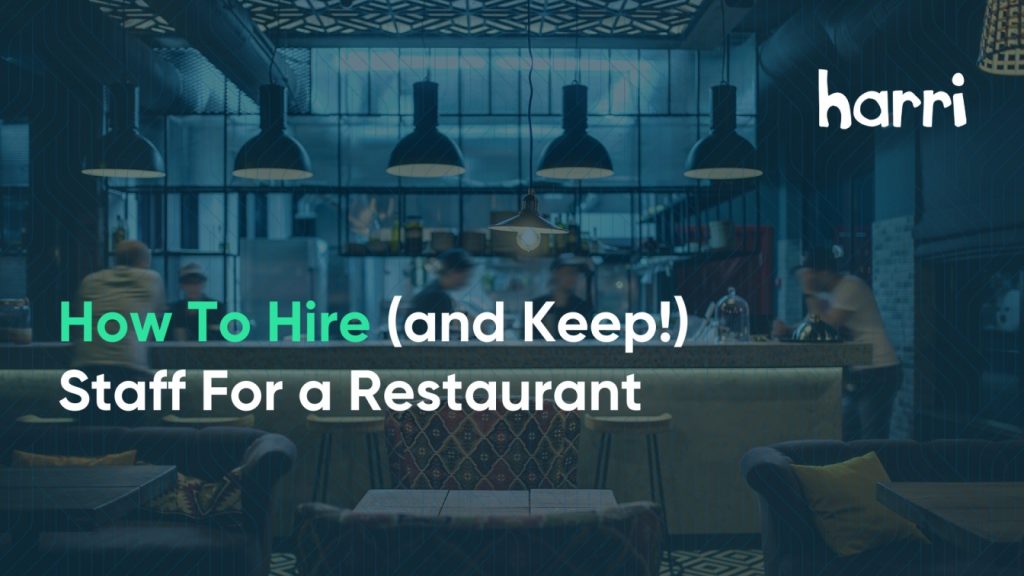How To Hire (and Keep!) Staff For a Restaurant

- By Harri Insider Team | February 2, 2023
Recruiting at the top of the employment funnel is especially important for restaurant owners and managers. Your strategy for advertising job openings, navigating ongoing labor shortage, and pinpointing hard workers that are willing to make significant contributions, will have the potential to make or break your restaurant business. From cooks to servers, dishwashers, buspersons, bartenders and managers, each employee plays an important role in a restaurant’s success.
Part of the challenge of hiring quality restaurant staff is finding hard workers that are willing to wear multiple hats. Hiring restaurant staff that are multifaceted is important for several reasons. First, it allows for a more flexible and adaptable workforce. When employees are able to take on multiple roles and responsibilities, it can help to ensure that the restaurant runs smoothly even when there are unexpected absences or changes in demand. This can be especially important in the fast-paced and dynamic environment of a restaurant, where staff need to be able to respond quickly to changing conditions.
When employees are able to work together and support one another in different roles and responsibilities, it can foster a sense of teamwork and cooperation that can help to improve morale and productivity. The importance of having a hard-working and collaborative team should not be underestimated. In this blog, we’re taking a quick look at different restaurant roles and the best strategies to hire and keep quality staff for a restaurant.
Hiring restaurant staff: where to start
The steps of restaurant hiring are integral to the operation’s success. Follow the hiring steps as detailed below and your restaurant will thrive. Above all, recognize that hiring and retaining excellent staff is a known challenge due to the high turnover rate of the industry, but with the right processes in place you can still maximize potential and establish great retention.
The time you invest in posting job ads and interviewing has the potential to be a massive money sink unless you pinpoint candidates with a proven work ethic and a hunger for employment. Let’s shift our focus to the challenges of hiring restaurant staff.
Step One: understand staffing needs
Your restaurant staffing needs are distinct to your unique business. Though all restaurants have similar employment roles, your open positions at any given time are not the same as those of the next restaurant and so on. Take some time to review your imbalance of labor, be mindful of your current contributors’ willingness (or unwillingness) to shift to new roles as necessary and hire accordingly.
Instead of reacting and hiring someone just to backfill a position as quickly as possible, develop a comprehensive game plan. Write down your company’s needs in terms of both BOH and FOH. Once you have a clear understanding of the specific positions your restaurant needs to fill to reach its true potential, you can begin the employee search, hiring, and onboarding processes.
Step Two: spread the word
The laws of supply and demand hold true in the context of restaurant human resources. An influx of interested prospects makes it easier to fill open roles at reasonable wage levels. Get the word out about your openings and be patient as the resumes are submitted. Instead of relying on word-of-mouth advertising as restaurants relied on in years past, spread the message through online job boards, web-based local news sites, online/offline classifieds and even social media platforms.
If you don’t already have one, create a restaurant website that is regularly updated with information about your business including new job openings. Post descriptive job ads, include some highlights about working for your business and it won’t take long to generate interest from job-seekers. Consider using a talent attraction platform like Harri, which has the ability to automatically post jobs to industry-leading and third-party hospitality job marketplaces with millions of active job seekers.
Step Three: review applications
Now that you’ve cast a wide net both online and offline, it is time to review the catch. Analyze applications in-depth before reaching out to candidates to schedule interviews. Keep in mind, your time is worth money. Restrict interviews to those who seem legitimately interested in working in the restaurant industry as evidenced by their promptness in applying and/or work experience.
Step Four: conduct interviews
Write out a list of questions to pose to candidates during interviews. Pay close attention to candidates’ verbal responses and body language as they answer. Instead of portraying your restaurant as a utopian workplace void of conflict and problems, be straightforward. Highlight potential challenges that are likely to arise and ask candidates to explain how they would help your current team overcome those hurdles.
Staff for a restaurant: the critical hires
From managers to hosts, buspersons, servers and beyond, restaurants have a plethora of moving parts that take the form of human capital. Each restaurant employee performs an important function, and the efficiency of each of your teams can play a major role in your retention rates.
If everything works as planned, the individual parts of a restaurant will add up to a whole that is greater than the sum of its parts. But if, for example, a management team is dysfunctional, it can cause a negative domino effect on the morale and retention of your staff. Here’s a breakdown of the most important traits to look out for as you seek candidates for these critical roles.
Management
The best restaurant managers are leaders capable of showing their team how to get things done and also guiding others through words. Elite restaurant managers are open-minded and flexible, meaning they are willing to consider employee input when shaping policies and also willing to pitch in where necessary. In short, no role is beneath the manager. Employee sickness, termination and other unexpected factors will inevitably arise, creating the need for a temporary fill-in. Oftentimes, it is the manager who must step into such temporary roles to keep the restaurant operating like a well-oiled machine.
It is important to keep in mind that a good manager can have a significant impact on the retention of other staff members, which is essential for the long-term success of the restaurant. By selecting a manager with the right combination of skills and experience, restaurant owners and operators can ensure that their establishment runs smoothly and is staffed with motivated and engaged employees.
When searching for a manager, it is essential to look for individuals who possess a combination of skills and experience that align with the specific needs of the restaurant.
The ideal manager should have a strong leadership presence, capable of effectively leading by example and fostering a positive and productive working environment. They should possess a deep understanding of the industry, including current trends and best practices, allowing them to make informed decisions about menu offerings, service standards, and operational efficiencies. Effective communication skills and the ability to resolve conflicts and provide constructive feedback to staff members is a must to ensure smooth operation and keep your team happy and engaged.
Ideally, the manager you hire for your restaurant will have several years of industry experience in a non-manager role.
Front-of-house staff
Staff for a restaurant is split into two operating components: the front-of-house and the back-of-house. The front-of-house, often referred to by the acronym of FOH, is the part of the restaurant that customers access, meaning it consists of the bar and dining space. FOH employees have refined interpersonal skills as they interact with guests during service hours.
Hiring front-of-house staff for a restaurant is a crucial step in creating a positive customer experience, which is why it is vital to look for individuals who possess a combination of skills and attributes that align with the specific needs of your business.
Consider candidates with demonstrated ability to interact with customers in a friendly and professional manner, handle complaints and special requests efficiently, and provide a high level of service. Front-of-house staff should have a good understanding of food and beverages. They should be able to describe menu items accurately and make recommendations based on customer preferences.
Additionally, depending on your locality of operation, your staff will likely need mandated certifications in food safety and should possess an overall knowledge of food safety, sanitation and allergen protocols.
Finally, front-of-house staff should be able to use point of sales system and handle cash and card transactions, with good mathematical skills to handle payments and give correct change.
A good front-of-house team can help to create a positive working environment and provide excellent customer service which in turn, can help to reduce staff turnover and ensure that the restaurant is staffed with experienced, motivated employees who can provide a high level of service to customers.
Back-of-house staff
The BOH staff work in the back of the building, meaning the kitchen, the freezer and the storage area. This is the part of the restaurant restricted to staff members as it is behind the scenes, completely out of sight from customers and FOH contributors. Though BOH is not seen, it is integral to the functionality and success of the restaurant. The smooth functionality of BOH operations sets the stage for FOH to shine, serving delicious food to customers in a timely manner.
When recruiting back-of-house staff, you’ll likely start with individuals who have a strong culinary background, with knowledge of food preparation techniques, ingredient sourcing, and kitchen safety protocols. Regardless of if you run a fine dining establishment or a quick service hole-in-the wall, you must create dishes that are visually appealing and meet the restaurant’s standards.
Beyond food prep experience, back-of-house staff should have good organizational and time management skills, with the ability to work in a fast-paced environment and multitask effectively. They should also be able to work well in a team and be able to take direction from their superiors.
Just like the rest of your team, back of house staff need to have knowledge of food sanitation and safety regulations and should be able to follow health and safety guidelines and maintain a clean and organized working environment.
Even if you can’t seem to find candidates with ideal years of experience, don’t hesitate to consider back-of-house staff who demonstrate adaptability and willingness to learn. These team members should be open to new ideas, techniques and equipment, and be able to adapt to changes in the menu or kitchen environment.
What to look for in restaurant employee candidates
The ideal traits, qualities and skills for restaurant employees are not the same as those for workers in other industries. The best restaurant contributors are cordial, diligent and service-oriented. Diversity also matters in terms of skills, knowledge and experience as the most valuable restaurant employees are capable of shifting roles at a moment’s notice.
Above all, a focus on work ethic is one of, if not the most important quality. Conduct reference checks to get a sense of whether employment prospects have a track record of earning their keep.
If you’re faced with an influx of applications, you might be struggling with keeping track of all of your potential candidates. If this describes your position, you’ll likely find Harri’s talent pool feature useful. This service on the Harri platform allows you to “tag” candidates, so you can quickly and easily filter through all those you’ve previously interviewed.
This way, if a candidate is highly qualified but a role is not currently available, you can easily reach out to them again when the time is right. In addition, you can use the main search filter on the Talent Pool to search for specific keywords within candidates’ profiles, such as job title, schedule, previous employer, and abilities, among others.
How to retain restaurant staff
Employee retention is half the battle of restaurant success. Hiring the right employees won’t make the intended impact unless they stay for at least a year. However, most restaurant managers and owners have become accustomed to a high turnover rate, assuming it is the nature of the industry. You can decrease your attrition rate through a thorough employment screening process. Highlight individuals who are most likely to assimilate to your employment culture, treat them right and they will be inclined to stay.
Provide positive reinforcement for a job well done. Employees who feel respected for their contributions really are that much more likely to remain with the restaurant for years. Positive reinforcement takes the form of bonuses and raises yet non-monetary reinforcement also matters. Employee benefits and even verbal praise for exceeding expectations lift the spirit and hikes retention.
Recognize that employees grow tired of performing the same activities at work day-in, day-out and provide opportunities for new experiences in the workplace. Give your team members a chance to make diverse contributions through flexible work roles and they’ll find the experience in your restaurant is that much more fulfilling.
Upgrade Your Hiring Process with Harri
Harri’s talent acquisition solution is here to help your restaurant or other hospitality business reach its potential. Tap into our human resources capabilities, including our AI-powered conversational ambassador, customized applicant flows and multi-channel job broadcasting and we’ll help you fill your open positions with legitimate difference-makers. Reach out to us today to learn more about how we can upgrade your hiring process and request a demo of our product.



















